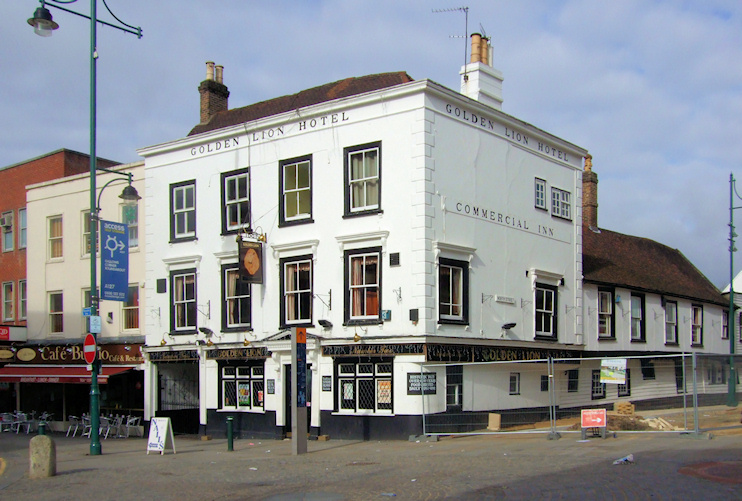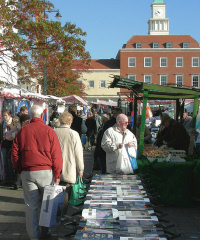Romford
Romford, Havering
A shopping destination and the ‘capital’ of Havering since the Middle Ages, situated five miles east of Ilford

Romford’s name was first recorded in the mid-12th century and probably referred to a broad (or ‘roomy’) ford across the Mercke-dych or Markediche (‘boundary ditch’, which was later called the River Rom locally and the Beam River further south).
The settlement initially evolved around a chapel dedicated to St Andrew that was in existence by 1177. This was located to the south-west of the modern centre, in the vicinity of what later became Oldchurch Park.
Henry III granted Romford the right to hold a market in 1247 and added permission for a Whitsun fair three years later. The focus of the village shifted to the new marketplace, whereupon it is said that the chapel was swallowed up by an earthquake, although its bells could still be heard on St Andrew’s Day. Seismic event or not, the old chapel was ruined beyond use by the end of the 14th century and a new church was built in the marketplace in 1410, and dedicated to the Virgin Mary and St Edward the Confessor.
By the 15th century the market was well-known for the sale of leather goods made in nearby Hornchurch. The proverbial Essex advice that one should “go to Romford to be new-bottomed” referred to the market’s reputation for well-made leather breeches. From the 17th century it became a very large agricultural market, selling farm tools, livestock, fruit and vegetables.
As a coaching halt on the London to Colchester road, Romford’s inns and hotels flourished. Shown in the photo above, the Golden Lion dates from the 16th century (when it may have been a galleried inn), though its Market Place frontage is early Victorian. Fortunately it survived a plan to demolish it in the 1950s. Edward Ind started a small brewery at the Star Inn in 1799 and later joined forces with Octavius and George Coope to form a partnership that became one of the largest brewers in the country.

The town was still small and its environs almost entirely agricultural when the Eastern Counties Railway arrived in 1839, boosting both the market and the brewing industry. Landowners began to sell off their estates for suburban development in a protracted process that began with the now-vanished New Romford and Laurie Town, to the west and east respectively, and continued well into the 20th century with schemes such as Marshalls Park to the north.
The Anglican parish church of St Edward the Confessor was built on the site of its predecessor in 1849–50. The Catholic parish church, also dedicated to St Edward,† was rebuilt soon afterwards in Park End Road. In working-class New Romford a new incarnation of St Andrew’s was completed in 1862.
From the 1920s onwards the town centre profited from the arrival of new branches of national retailers alongside long-established local firms centred on the so-called ‘Golden Mile’ of South Street and North Street. Here and in the High Street, cottages and slum terraced houses were demolished to make way for wider thoroughfares and modern commercial premises. At the same time, light industrial units appeared on the outskirts, especially along the Eastern Avenue, north of which a new township mushroomed around Collier Row.
While the residential district expanded in every direction, enlightened developers and councillors ensured that a string of green spaces garlanded the growing borough, a status it attained in 1937.
The town centre was redeveloped after the construction of the ring road in the late 1960s, and parts have since been redeveloped all over again. The Ind Coope brewery closed in 1993 and much of the site lay idle for almost a decade. Some of the peripheral brewery buildings were preserved, while a large area was razed and replaced by blocks of flats and a shopping and leisure complex called The Brewery (and its 1774 car parking spaces).
Nearby there are the independent traders of Romford shopping hall and two other malls: the Liberty and the Mercury. Romford market is open on Wednesdays, Fridays and Saturdays. The town centre is also one of the most popular ‘pubbing and clubbing’ destinations in outer London.
Queen’s hospital was built in 2003–6, consuming most of Oldchurch Park. Havering museum opened in 2010 at a corner of the old brewery site. To the west, Romford greyhound stadium has races on Monday, Wednesday, Friday and Saturday evenings, and Thursday and Saturday daytimes.
According to a YouGov survey in 2020, only 34% of Londoners consider Romford to be part of London, compared to 46% who do not.
In the late 1660s the colourful adventurer ‘Captain’ Thomas Blood lived at an apothecary’s shop in Romford under an assumed name. In 1671 he almost succeeded in stealing the crown jewels.
